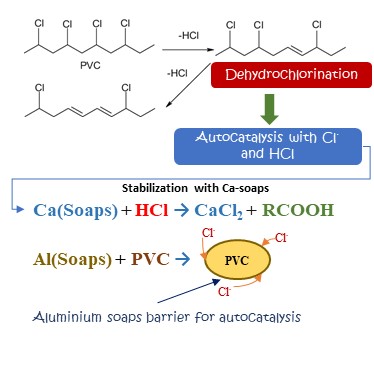Effect of Sunflower Oil-Based Metal Soaps on the Thermal Stability of Polyvinyl Chloride
DOI:
https://doi.org/10.31489/2959-0663/1-25-4Keywords:
polyvinyl chloride, thermal stabilizers, sunflower oil, metal soaps, calcium soaps, aluminum soaps, metal carboxylates, thermogravimetryAbstract
Calcium and aluminum soaps were synthesized by metathesis method based on sunflower oil, a bio-based raw material, and were applied separately and together to polyvinyl chloride (PVC) as environmentally friendly thermal stabilizers. A number of properties of metal soaps were studied and applied to PVC, and the characterization of the mixtures was carried out using Fourier Transform Infrared Spectroscopy (FTIR). Thermogravimetric and differential thermal analysis (TG-DTA) methods were selected to evaluate the thermal stability of the polymer. A commercial NV-710123-branded thermal stabilizer based on calcium-zinc stearate was selected for the comparative evaluation of the effectiveness of metal soaps. According to the TGA results, the Ca and Al soaps were found to be more effective than the commercial thermal stabilizer. While the pure PVC sample lost 8.93 % of its mass at 269.8 °C, the samples added with Ca, Al soaps, commercial thermal stabilizer and a mixture of Ca and Al soaps at a ratio of 4:1 lost 2.7 % of their mass at 263.5 °C, 3.56 % at 265.7 °C, 4.56 % at 263 °C and 4.12 % at 261.1 °C, respectively. While pure PVC lost more than 44 % of its mass at 300 °C, the mass of the polymer sample with the Al soap added, which was the most effective component at this temperature, decreased by only 16.83 %. This is due to the fact that the Al soap component has a barrier effect and prevents the autocatalytic effect of HCl formed during the degradation of PVC. This allows these components to be used as thermal stabilizers.

Downloads
Published
How to Cite
Issue
Section
License
Copyright (c) 2024 Roman M. Hasanov, Rasmiyya E. Mammadova, Sabir Q. Amirov, Zumrud D. Aliyeva

This work is licensed under a Creative Commons Attribution-NonCommercial-NoDerivatives 4.0 International License.
This work is licensed under a Creative Commons Attribution-NonCommercial-NoDerivatives 4.0 International License.
Authors retain copyright and grant the journal right of first publication with the work simultaneously licensed under a Creative Commons Attribution License (CC BY-NC-ND 4.0) that allows others to share the work with an acknowledgement of the work's authorship and initial publication in this journal.



